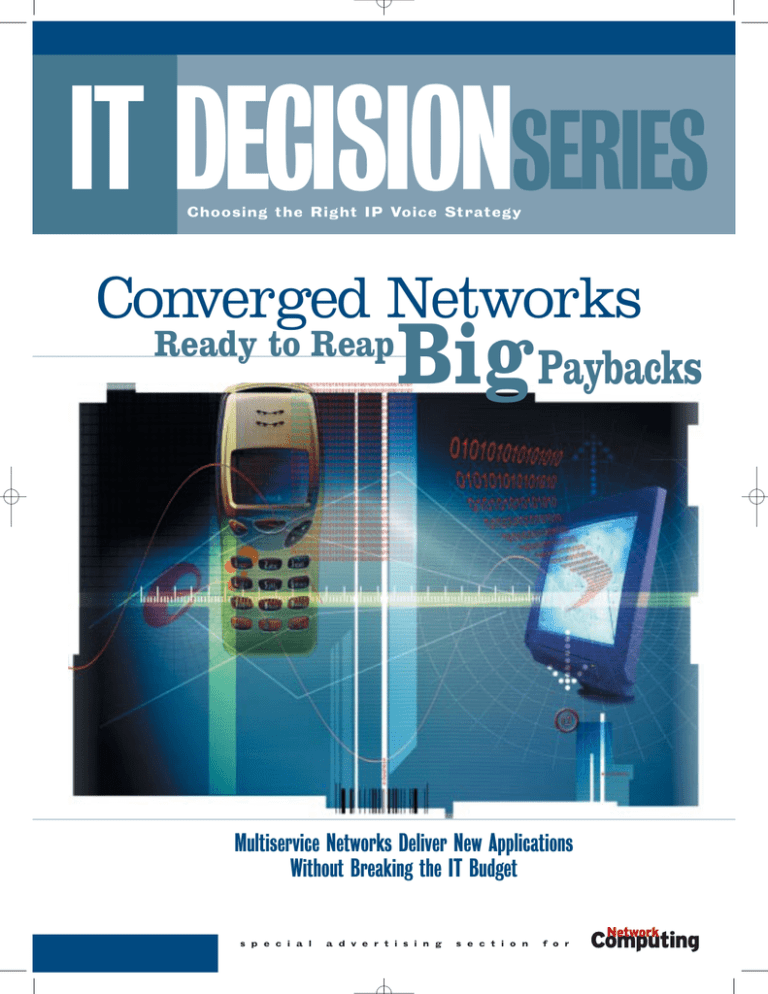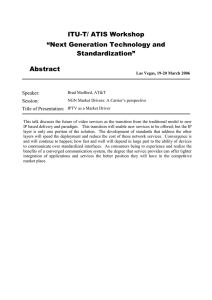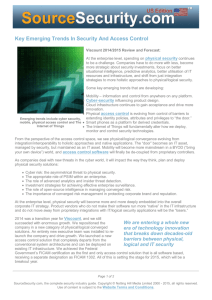
IT DECISIONSERIES
Choosing the Right IP Voice Strategy
Converged Networks
Ready to Reap
Big Paybacks
Multiservice Networks Deliver New Applications
Without Breaking the IT Budget
s p e c i a l
a d v e r t i s i n g
s e c t i o n
f o r
special advertising section
Converged Networks
Ready to Reap
Big Paybacks
Multiservice Networks Deliver New Applications Without Breaking the IT Budget
E
ven in the face of years of hype, most
businesses have taken a “wait and
see” approach toward dumping their analog
phone system and creating a truly
converged network infrastructure. With the
impressive failure of the dot-com revolution
fresh in the IT architect’s mind, it isn’t too
surprising that businesses remain skeptical
about removing functioning voice solutions
already in place. But businesses of all sizes
are re-examining the promise of the
converged network, and many are finding
that benefits—in terms of both lower cost of
ownership and greater utility—now easily
justify the capital outlay.
So what’s changed? Certainly, the
list of promised efficiencies for converged
voice and data networks hasn’t changed.
In terms of the cost of ownership, the
value of maintaining a single cabling plant
and vastly improved manageability of
devices such as next-generation IP PBXes is
undeniable. Initial purchase prices also
continue to become more attractive, particularly for layered applications like voicemail,
automated attendants and automated call
routing. What has changed significantly,
however, is the ability of the technology
to deliver on those promises. Availability,
reliability and manageability of both
the underlying infrastructure and the
application platform are vastly
improved and ready for prime time.
What’s also changed is the view of
what a converged network needs to do.
What originally started as an image of taking
phone calls on your computer has come full
circle. Instead of viewing the desktop or
laptop computer as the nexus for functions
of the network, most industry observers now
expect that such general-purpose computers
will be the minority of devices on the network.
The majority of devices will have a single
D2
Network Computing
purpose and may be wired or wireless.
Examples run the gamut from phones to ID
badges, and from environmental and security
devices to inventory control tags.
Achieving this vision of the converged
multiservice network still requires the right
infrastructure, and most organizations are
not there yet. Affordable bandwidth is the
key enabling technology, but along with it
must come rock-solid reliability, powerful
management and end-to-end monitoring
capabilities. Vendors are bringing products
to market with exactly these capabilities.
But there are still important differentiators
for businesses of all sizes.
Striking a Balance for the SMB
While it is tempting to talk about convergence
as a monolithic concept, the truth of the
matter is that small and medium businesses
have immensely different concerns from
those of their enterprise brethren. Perhaps
the most important distinction is the set of
responsibilities that fall to a small group of
workers (sometimes just one) in nontechcentric SMBs. Companies with a few hundred
employees aren’t interested in new IT
capabilities if it means having to add IT staff.
The mantra here is as it has always been—
keep it simple. Vendors know the mantra well
and have responded with equipment that is
not only simple to install and manage, but
also increasingly simple to cost justify.
In the spirit of the “keep it simple”
philosophy, many small businesses are
taking the convergence rewards where they
are most obvious. For example, some are
taking a lead from their enterprise counterparts and using IP telephony for their internal
site-to-site calling needs. In the enterprise, it
has been common to converge voice, data
and often video on wide-area frame relay
networks. The cost savings have been such
www.nwc.com\custom\itdecision\ipvoice
special advertising section
Converged Multiservice Network
that enterprise buyers have found the
solution to be a no-brainer. To make it a
no-brainer decision for SMBs, vendors needed
to create systems that are particularly
designed for the SMB market. Craft Diston
Industries is a case in point.
Choosing the Right Partner
Craft Diston is a shower door, tub enclosure
and mirror closet door manufacturer with
five manufacturing plants located across
the United States. The company also has
three distribution centers and owns two
subsidiaries. The company created a frame
relay network to link all of its sites and
found itself in the market for a phone system
that could save money and provide new
features by using the frame relay system to
support internal calling needs. Today, that’s
exactly what the company has: IP PBXes
that, by using the existing frame relay
network, save the company some $20,000
per month in long distance charges.
However, there were some significant bumps
on the road to its new phone system.
A multiservice network infrastructure supports new and existing applications by providing high bandwidth and low latency along with end-to-end management and monitoring. New network devices are
supported by edge switches that supply power. IP-capable PBXes support analog phones and traditional
PSTN connections as well as local and wide area VoIP (voice over IP) applications.
“We were initially sold a system designed
for the enterprise, and that’s where the
problems started,” says Jesse Santana, Craft
Diston’s director of IT. The costly system was
so complex that after eight months it still
was not serving all of Craft Diston’s sites.
The vendor was forced to remove the system,
and Craft Diston sharpened its product
requirements to ensure that its next
system would be more appropriate for the
company’s needs. The company decided
that it needed to focus on reducing long
distance calling charges between its
sites as well as look for a system that
was cost-effective and easy to manage—in
other words, keep it simple. Santana ended
up choosing a system from AltiGen
Communications. A pioneer in the market,
AltiGen offered server-based IP PBX
systems. The AltiGen system was installed
and working at all Craft Diston locations in
less than a month.
The AltiGen solution includes a number
of redundant systems, such as power supplies
and hard drives, to provide superior uptime.
www.nwc.com\custom\itdecision\ipvoice
Network Computing
D3
special advertising section
The company also offers centralized
management of distributed systems through
its Distributed Intelligence Network
Architecture (DINA). Applications like
voicemail and basic call center functionality
are run directly on the PBX. Advanced
applications, like AltiGen’s AltiContact
Manager, run on dedicated turnkey hardware.
These features make AltiGen’s products
highly flexible, affordable and scalable,
allowing SMB customers to choose just how
much of a converged network they need to
run—with the option of converging other
parts of the network as the need arises.
Getting Enterprise Infrastructure
Right
For larger customers, next generation
multiservice networks require thinking
about not only voice, video and data, but a
myriad of other applications as well—each
with its own requirements for bandwidth,
latency and jitter. The idea is that every
system that once required its
own cabling plant—like
phones, security scanners
and cameras, and environmental monitors—will now
all use the data network.
This is by no means a
complete list of the new
applications that will find their
way onto the network of corporations, government agencies and service
providers. These applications will oftentimes
be enabled by the plummeting price of both
wired and wireless data interfaces.
Two standards in particular are enabling
convergence for all manner of devices.
The first is POE or Power over Ethernet
(802.3af). This standard calls for edge
devices to supply up to 15 watts of
power to devices such as digital
cameras, IP phones and wireless access
points. Two methods are used for supplying
POE. For existing installations, a “midspan”
device can be introduced to supply power on
legacy switch ports. Companies like Extreme
Networks and Foundry Networks are also
building POE support right into their latest
edge switches. The second standard of
recent note is the sFlow (RFC-3176). This
standard specifies methods for monitoring
D4
Network Computing
BEST
PRACTICES
Richard De Soto
Sr. Vice President and
Chief Marketing Officer
AltiGen Communications
For small and medium businesses, the cost
savings expected from implementing an IP
Telephony solution are all too often eaten up
by the complexity of solutions intended for
large enterprises. “Customers with fewer than
1000 seats have told us horror stories about
their attempts to install and manage systems
made for far larger businesses,” says Richard
De Soto, senior vice president and chief
marketing officer for AltiGen Communications.
“These customers need solutions developed
with their needs in mind. ROI break-even
should occur in less than a year.”
www.altigen.com
De Soto also strongly recommends selecting
systems that allow for a best-of-breed underlying network infrastructure. “IP PBXes that
work only with that vendor’s infrastructure
gear should be questioned, since they may
lock you into equipment that does not fit
your specific needs. The data network and
the telephony system that uses it should be
two different decisions. Both vendors,
however, should offer interoperability with
each other’s solution.”
Finally, DeSoto urges buyers to look at
system security and add-on applications.
“Both the infrastructure design and the IP
telephony products should consider security.
Support for VLANs, firewalls and VPNs is
critical—particularly in multisite installations.
Buyers should also look for reasonably
priced add-on applications like basic call
center functionality. Oftentimes, this is
where the really big payback comes.”
traffic flows from one edge of the network to
another. It is vitally important for finding
www.nwc.com\custom\itdecision\ipvoice
special advertising section
and correcting network or application faults,
since standalone traffic analyzers are
relatively useless in today’s edge-to-edge
switched networks.
Forklift Upgrade or Constant
Evolution
But even as these new standards are
vital to enabling certain new network
applications, a solid converged infrastructure basically comes down to reliability,
performance, manageability and cost. These
elements are critical, but they are also open
to interpretation. Examples in contrast are
the Great London Authority (GLA), which
recently completed a new city hall in
London, and Phonoscope, which runs a
large metropolitan area network in the
greater Houston area.
GLA’s IT staff had a full plate with
its move to a new building. Along
with a new network, the IT staff
chose to upgrade to Windows 2000
on servers and Windows XP on workstations. That, along with an entirely
new network, led to the decision to take a
staged approach to adopting IP telephony.
The goal was to create a network capable of
handling any application reliably.
Essentially, GLA was looking for a
future-proof network. To meet its
needs, the company chose Foundry
Networks for its infrastructure vendor
and also implemented some Mitel IP
telephony gear for such applications as
speech-enabled auto attendants and call
center functionality.
Foundry was chosen in part because
GLA appreciated Foundry’s upgradable architecture and modular design. Foundry also
promised to vastly improve network reliability.
GLA purchased two BigIron 8000 Layer 3
switches populated with gigabit Ethernet
ports to form the core of its network. It also
purchased 15 FastIron Layer 2/3 switches to
provide 10/100 connectivity to edge devices.
Since modules are interchangeable within the
BigIron and FastIron lines, upgrading and
maintaining spare parts is greatly simplified
with the Foundry gear. GLA is confident that
it will be able to upgrade to 10 Gbps Ethernet
if the need should arise. With its new network,
GLA expects 99.99 percent uptime.
D6
Network Computing
BEST
PRACTICES
Anthony James
Product Marketing Manager
for Enterprise Applications
Foundry Networks
Everyone has heard horror stories about
failed attempts to implement a converged
multiservice network, and that doesn’t come
as much of a surprise to Anthony James,
product marketing manager for enterprise
applications at Foundry Networks. “Much of
the planning that’s been done around the
purchase of converged networks assumes that
voice, video or data applications will always
behave as expected. When that ‘perfect world’
assumption turns out to be wrong, IT professionals often find they don’t have the tools to
figure out what happened and where in the
network problems are occurring,” says James.
“Historically, users at the edge of the network
have exchanged data with servers in the data
center. New applications on the multiservice
network, like voice or video, imply far more
edge-to-edge connections. The network has to
provide new facilities for monitoring and
troubleshooting those connections.”
www.foundrynetworks.com
As part of his four critical purchasing criteria,
James recommends that customers look for
systems that provide RFC 3176 or sFlow
application monitoring in hardware. “To get a
truly dependable multiservice network, you
absolutely must look for these four items:
sufficient bandwidth, five nines reliability,
end-to-end traffic management and hardwarebased monitoring. Networks need to be
robust, self-healing and self-configuring, but
without monitoring you’re invariably asking
for trouble.”
Keep It Simple
Phonoscope, on the other hand, has evolved
its multiservice network over time. As a MAN
(metropolitan area network) provider, it must
www.nwc.com\custom\itdecision\ipvoice
special advertising section
meet the diverse needs of the oil, energy and
medical community that it primarily serves
in the Houston area. In 1998 the company was
running a complicated ATM network that it
found far too costly to run. The company
began working with Extreme Networks to
replace its ATM gear with high-performance
Ethernet switches. “Initial trials were so
successful that we began the move to an
all-Ethernet network and have never looked
back,” says Robert Jacobs, data systems
director at Phonoscope. “Currently 99 percent
of our network runs on Extreme gear.”
Jacobs goes on to explain that
simplicity of design is Phonoscope’s key
to success. “We are lucky to have a lot of
fiber resources at our disposal, so rather
than create a bandwidth-constrained
network that requires extensive monitoring
and tuning, we’ve created an overprovisioned layer two network. Customers buy
VLANs from us, not IP subnets.”
For management, Phonoscope uses
Extreme’s EPICenter policy manager. “We
can provision VLANs more or less on
the fly, usually requiring fifteen
minutes or less,” says Jacobs. While
Phonoscope has been able to produce a
contention-free environment, Extreme realizes
that this is not always possible. In fact, on its
latest line of switches, along with POE
support, the company has increased the
possible number of QoS queues from eight to
64. This gives network architects the ability
to precisely control the bandwidth allocated
to certain applications.
Whether small business or enterprise,
the time has come to implement elements of
a converged network. Infrastructure and
application equipment vendors offer mature
products well-suited to the task, and the
benefits of doing so are more clear and
plentiful than ever. But as always, the
challenge is to build the right environment
from the network foundation on up.❋
BEST
PRACTICES
Duncan Potter
Vice President of
Marketing
Extreme Networks
IT architects are beginning to realize that
next generation networks are going to have to
do a lot more than simply carry voice, video
and data. What’s less obvious is what really
allows convergence to work appropriately in
the enterprise. “Customers used to shopping
for network solutions have heard the pitch
that deploying VoIP is merely a matter of
seamlessly tying together a similarly branded
IP phone with a network switch and flipping
the button,” says Duncan Potter, vice president
of marketing for Extreme Networks. “That
advice is shallow. Remember, VoIP technologies
have already been around for years, but
implementing the right foundation to handle
them has been rare.”
www.extremenetworks.com
“Building converged infrastructure means
taking a new look at several key requirements,” Potter continues. “These include
millisecond or hitless failover to maintain the
most sensitive connections, highly granular
QoS capable of creating guaranteed throughput
and scalable bandwidth to allow all converged
applications to coexist. But above all, keep the
infrastructure as simple and consistent as possible to ensure that the total cost-of-ownership
(TCO) benefits of converged infrastructure are
not submerged in the cost of the complexity of
managing it.”
© 2003 CMP Media LLC, CMP Integrated Marketing Solutions.
All Rights Reserved.
VICE PRESIDENT/DIRECTOR: Joseph Braue
ASSOCIATE PUBLISHER, WEST: Pamala McGlinchey
DIRECTOR OF PROJECT MANAGEMENT: Karen White
PROJECT MANAGER: Claire Meirowitz
DESIGN TEAM: CMP Creative Services East
FOR MORE INFORMATION: jbraue@cmp.com,
or 212-592-8214
D8
Network Computing
www.nwc.com\custom\itdecision\ipvoice






